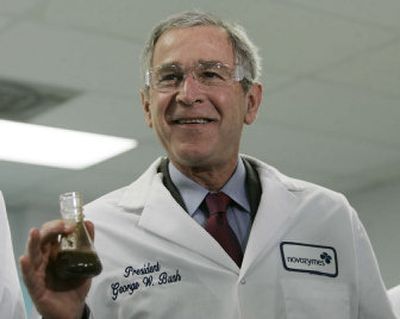Ethanol plant the latest stop on Bush science tour

FRANKLINTON, N.C. – President Bush is devoting considerable time these days to scientific matters.
Four weeks ago, he toured a chemical plant in Delaware. Earlier this month, he visited a Virginia computer-chip manufacturer. On Wednesday, at a hospital in Tennessee, he watched a video of a surgical robot excising cancerous tissue, prompting his host to ask, “You OK with the blood?”
And on Thursday, he studied what it will take to put cellulosic ethanol in your tank. The fuel is made when enzymes or bacteria break down agricultural waste, switch grass, wood chips and other forms of biomass. Scientists hope the process that turns plants into a burnable liquid can be tamed to economically produce at least a partial substitute for fossil fuels.
The president has been talking about this technology for more than a year, and he has made it a centerpiece of his 2007 domestic policy agenda, built around proposals to reduce U.S. gasoline consumption by 20 percent in 10 years by developing renewable and alternative fuels and increasing reliance on nuclear energy.
His proposals would require drivers to increase their use of alternative fuels by 30 billion gallons by 2017, up from the current 5 billion gallons. It would be the key to trimming U.S. reliance on foreign supplies of oil, which Bush sees as a national security liability, and to reducing carbon emissions, which are released when oil products are burned and are a major component of the greenhouse gases blamed by most scientists for global warming.
“I know it sounds like a pipe dream to some – you know, there goes the optimistic president talking again,” said Bush, describing himself as “just a history major.”
But the scientists alongside him during his visit to Novozymes North America Inc. “are providing the brain power necessary to help plants like this develop technologies that will enable us to convert wood chips into fuels that are running automobiles,” he said.
Bush toured the laboratories and factory where enzymes are produced and used to quicken the transformation of plant starch into fermentable sugars, a key step in producing ethanol.
The Union of Concerned Scientists, a nonprofit organization that focuses on issues of the environment and peace and often disagrees with Bush, said its analysis indicated that if Bush’s energy goals are met primarily by using ethanol, global warming pollution could be reduced by 160 million metric tons in 2017 – an amount it likened to taking nearly 24 million current model cars and trucks off the roads.
In recent weeks, Bush has made stops across the country in an effort to focus the media spotlight on his domestic policies – he discussed environmental issues in Shenandoah National Park in Virginia and his health care proposals in Tennessee, for example – instead of the increasingly unpopular war in Iraq. Here in North Carolina, he spent about an hour and a half immersed in the efforts to expand the use of biofuels.
Specifically, Bush focused on the potential, still under development, to use enzymes to help convert such agricultural waste as cornhusks and weed-like switch grass into cellulosic ethanol, rather than putting new demands on corn.
“The demand for corn, because of agricultural use and now energy use, is causing corn prices to go up,” he said, noting that hog farmers and cattle ranchers – both of whom use corn as feedstock – were feeling the pinch. “The question is, ‘How do you achieve your goal of less dependence on oil without breaking … the people dependent on corn?’”
The answer, he said, is the technology being developed at companies such as Novozyme.